How To Lessen the Impact of Ecommerce Returns
By Carl Bleich
04/11/2024

As the popularity of online shopping grows, so too does the frequency with which online shoppers are returning the products they’ve purchased online.
This has led to an ecommerce returns issue that’s leaving companies of all sizes and verticals trying to stop the bleeding on their bottom line.
- Online shoppers expect hassle-free return policies. Handling ecommerce returns effectively is crucial for maintaining customer satisfaction and loyalty.
- Ecommerce purchases have an average return rate that is significantly higher than brick-and-mortar stores. It is in every online business’ best interest to lessen the impact of purchase returns.
- Harnessing AI to analyze and understand your return rates is crucial to build the right customer experiences that mitigate the risk of shoppers returning their purchases.
Why Do Ecommerce Returns Happen?
Ecommerce returns refer to the process of customers returning purchased products or items to an online store or returning an online purchase to physical stores. When online customers make online purchases, they may occasionally find the need to return them due to factors such as:
- Dissatisfaction with the product: Customers might not be satisfied with the quality, appearance, or functionality of the item they received
- Sizing or fit issues: Clothing, shoes, and other items may not fit the customer properly
- Wrong or damaged product: In some cases, the customer may receive an incorrect item or a damaged product during shipping
- Change of mind: Customers may simply change their mind about the purchase and decide to return the product
To handle ecommerce returns, most online retailers have return policies in place. These policies outline the conditions, procedures, and timeframes within which customers can return products. Retailers may offer options like full refunds, store credit, exchanges for different items, or repair/replacement services, depending on their policies and the circumstances of the return.
Online retailers understand the critical role that customer expectations and satisfaction plays in driving repeat business and maintaining long-term customer relationships. While returns are an inherent part of the ecommerce ecosystem, excessive return rates can significantly impact profit margins and hinder customer lifetime value.
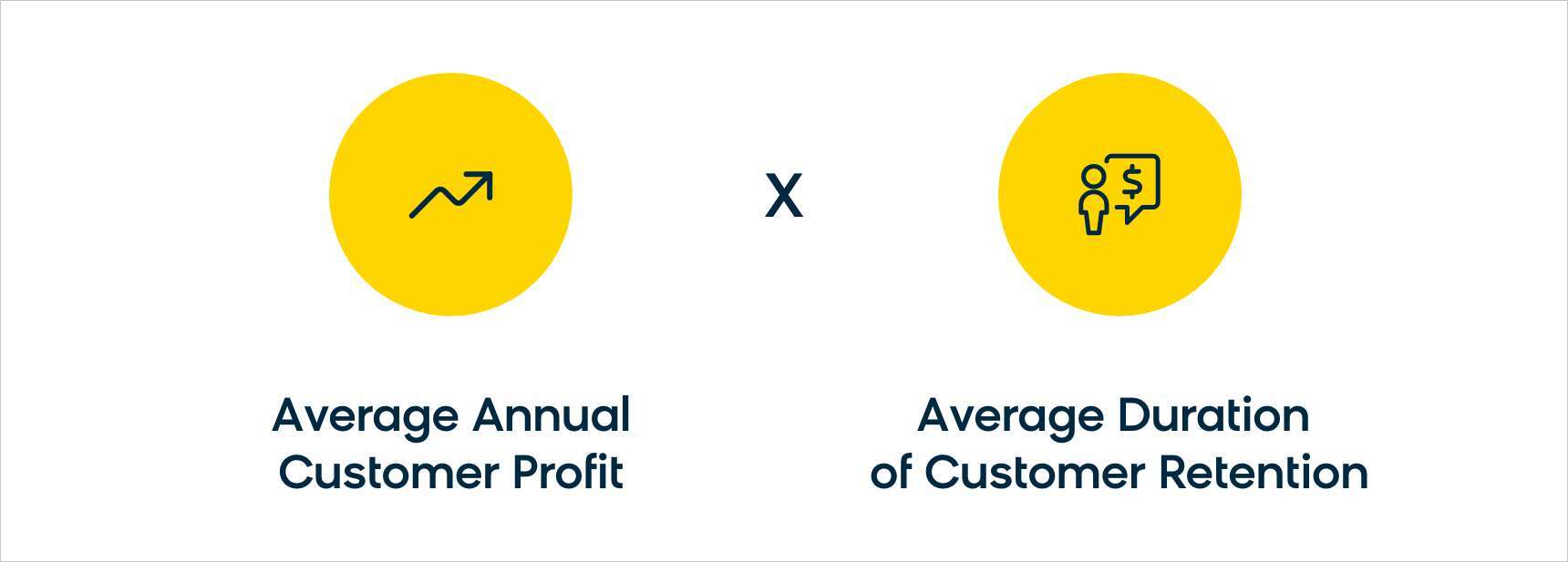
One of the key factors contributing to high return rates is the gap between the online and brick-and-mortar store experiences. Customers who shop online often face challenges such as inaccurate product descriptions, sizing discrepancies, or color variations, leading to dissatisfaction upon receiving their purchases. Consequently, they initiate the returns process, creating logistical complexities for the ecommerce store.
To address this issue, forward-thinking online retailers have implemented strategies like free return shipping and store credit to encourage customers to shop online with confidence. By offering free return shipping, ecommerce businesses alleviate the financial burden on customers when returning products that didn't meet their expectations. Moreover, providing store credit instead of refunds empowers customers to make alternative purchases, allowing brands to retain their business and improve overall customer satisfaction.
In addition to these customer-centric approaches, ecommerce stores are investing in advanced technologies and robust reverse logistics systems. These systems streamline the return process, making it more efficient for customers and reducing the chances of return fraud. By efficiently managing returns, online retailers can better control their inventory, mitigate losses, and allocate resources effectively.
But while all of the above information is important for context, what will really help you impact your bottom line is finding the right solution — what’s the best way to not only manage your ecommerce returns, but also reduce the financial stress they’re causing your company?
Managing ecommerce returns effectively is crucial for maintaining customer satisfaction and loyalty in the online retail industry. It involves streamlining the return process, ensuring timely refunds or replacements, and continuously improving customer service to address any issues that may arise during returns.
But that’s just the tip of the iceberg with ecommerce returns. If your company has marketing technology that can help pinpoint the consistent source of your product return problem, you can adjust your marketing strategies accordingly to mitigate loss.
And that could go a long way towards solving your ecommerce returns problem and maximizing your company’s profit.
Handling Returns in Ecommerce Effectively
Before we dive into the use cases that can help solve your ecommerce returns problem, let’s make sure that you have an appropriate product return program in place so that you aren’t alienating your customers.
What Does a Good Product Return Program Look Like?
A good product return program encompasses several key elements to ensure a smooth and optimal experience for customers. Here are some characteristics of a well-designed product return program.
Customer-Friendly Return Policy
A good return program begins with a clear and customer-friendly return policy. The policy should be easy to understand, concise, and readily accessible on your website. It should outline the conditions, timeframes, and procedures for returning products, as well as any applicable fees or restrictions. Make sure the return policy is written in easy-to-understand language and addresses common customer problems or issues.
User-Friendly Returns Process
The returns process should be simple and convenient. Provide customers with multiple options for initiating returns, such as an online returns portal, email, or phone number. Streamline the process by minimizing the paperwork and steps required from the customer's end. Offer prepaid return shipping labels or arrange for easy drop-off locations to further simplify the return process.
Efficient Communication Channels
Establish efficient and responsive communication channels — potentially using generative AI or conversational commerce — to handle customer inquiries or issues related to returns. Offer various channels like email, live chat, or phone support to accommodate different customer preferences. Respond promptly to customer inquiries, providing clear and helpful guidance throughout the return process.
Continuous Improvement
Regularly evaluate and enhance your returns process based on customer feedback, industry trends, and technological advancements. Stay updated with best practices and innovations in the ecommerce space to ensure your return program remains effective and competitive.

Why Managing Ecommerce Returns Actually Matters
Wouldn’t it be easier to just put the ecommerce return process on the back burner and focus on all of the important tasks you have on your plate as marketers? Well, there are many reasons why that would be a terrible strategy for your business.
Effectively handling and managing ecommerce returns is incredibly important. While they can be a burden on the time and finances of your business, ecommerce returns are a key part of the online shopping experience for customers.
An Easy Return Policy Is a Great Customer Retention Policy
A seamless and efficient return process contributes to customer satisfaction. In fact, 92% of customers are likely to buy again if the returns process is optimized.
When customers have a positive experience with returns, it enhances their trust in your company and increases the likelihood of them becoming loyal to your brand. On the other hand, a difficult or frustrating return process can result in customer dissatisfaction and hinder customer retention.
How a retailer handles returns can significantly impact its brand reputation. Word-of-mouth and online reviews play a vital role in shaping consumer perception. If a retailer consistently provides hassle-free returns, it can enhance its reputation as a reliable and customer-centric brand. Positive reviews and recommendations from satisfied customers can attract new buyers, while negative reviews about poor return experiences can deter potential customers.
Good Returns Management Can Set Your Brand Above the Rest
In the highly competitive digital commerce landscape, effective returns management can serve as a competitive advantage. By offering easy returns, generous policies, and outstanding customer service, a retailer can differentiate itself from competitors. Customers are more likely to choose a retailer that offers a straightforward and convenient return process over one with complicated or restrictive policies.
Repeat customers are the lifeblood of any ecommerce business. A smooth return experience can encourage customers to come back for future purchases. When customers feel confident that they can easily return a product if needed, they are more likely to take the risk of making a purchase, knowing they have an exit strategy. Retailers that prioritize customer satisfaction through efficient returns management can foster customer loyalty and increase repeat business.
A Strong Return Policy Pays Off in the Long Run
While returns may initially seem like a burden for retailers, effective returns management can lead to cost savings in the long run. By streamlining the process, retailers can reduce administrative overhead, minimize shipping and restocking expenses, and implement strategies to maximize value recovery from returned items (such as refurbishing or reselling). Moreover, prompt and efficient returns prevent unnecessary delays in issuing refunds, reducing customer inquiries and support costs.
Your Returns Process Can Yield Vital Insights
Returns provide valuable data and insights for retailers. Analyzing return reasons and patterns can offer useful feedback about product quality, sizing issues, or areas for improvement. Retailers can use this information to optimize product descriptions, enhance product quality, or even adjust their inventory strategies. By leveraging return data, retailers can make data-driven decisions to improve their overall business operations.
Ecommerce Return Statistics
The current state of ecommerce returns and ecommerce return rates is not a super positive one for online retailers.
Ecommerce return rates are typically significantly higher than brick-and-mortar stores. In a study by Shippo (and compiled by Richpanel), the data shows that the average ecommerce return rate sits somewhere between 20-30%.
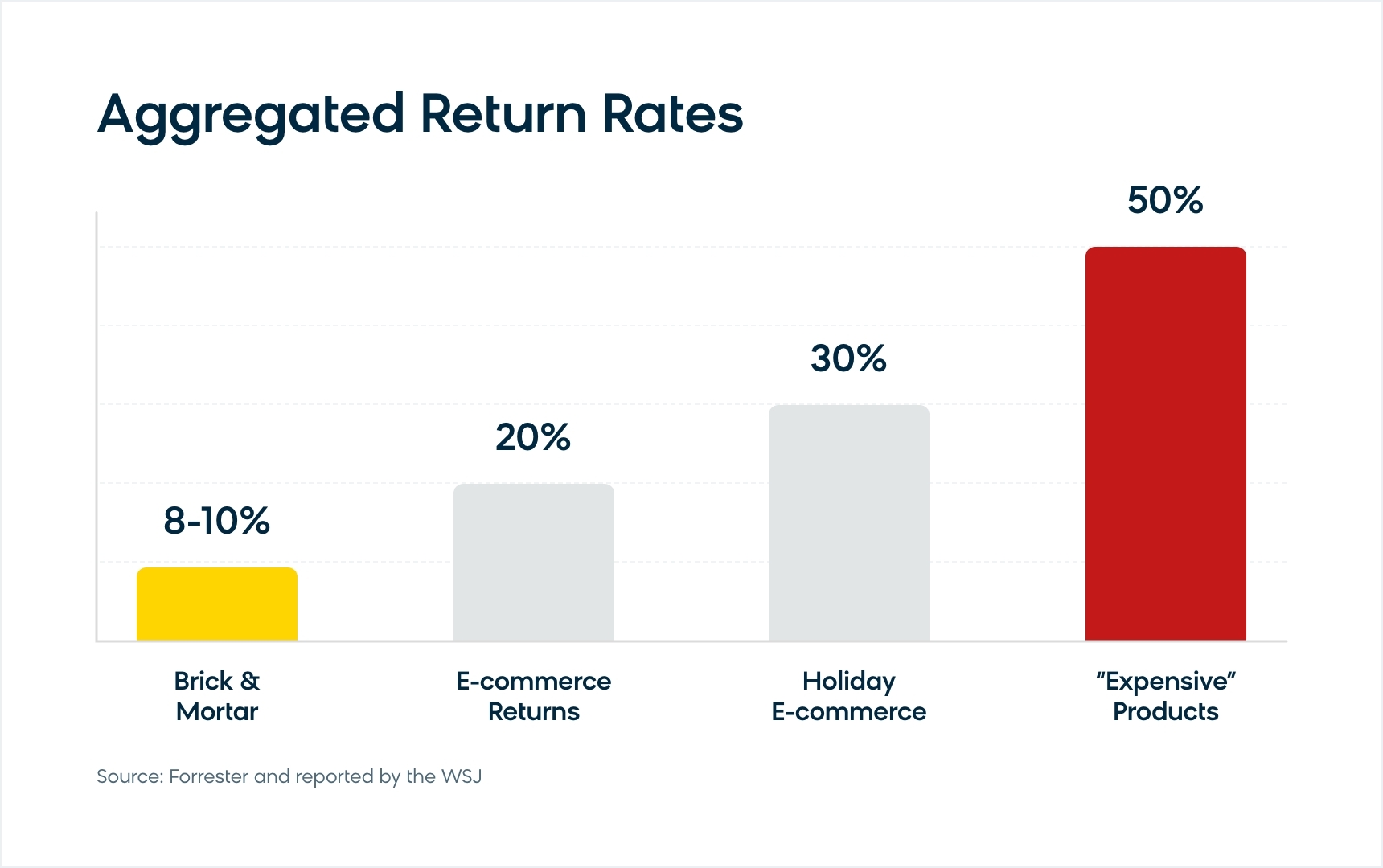
That same study also shows the average ecommerce return rates by vertical.
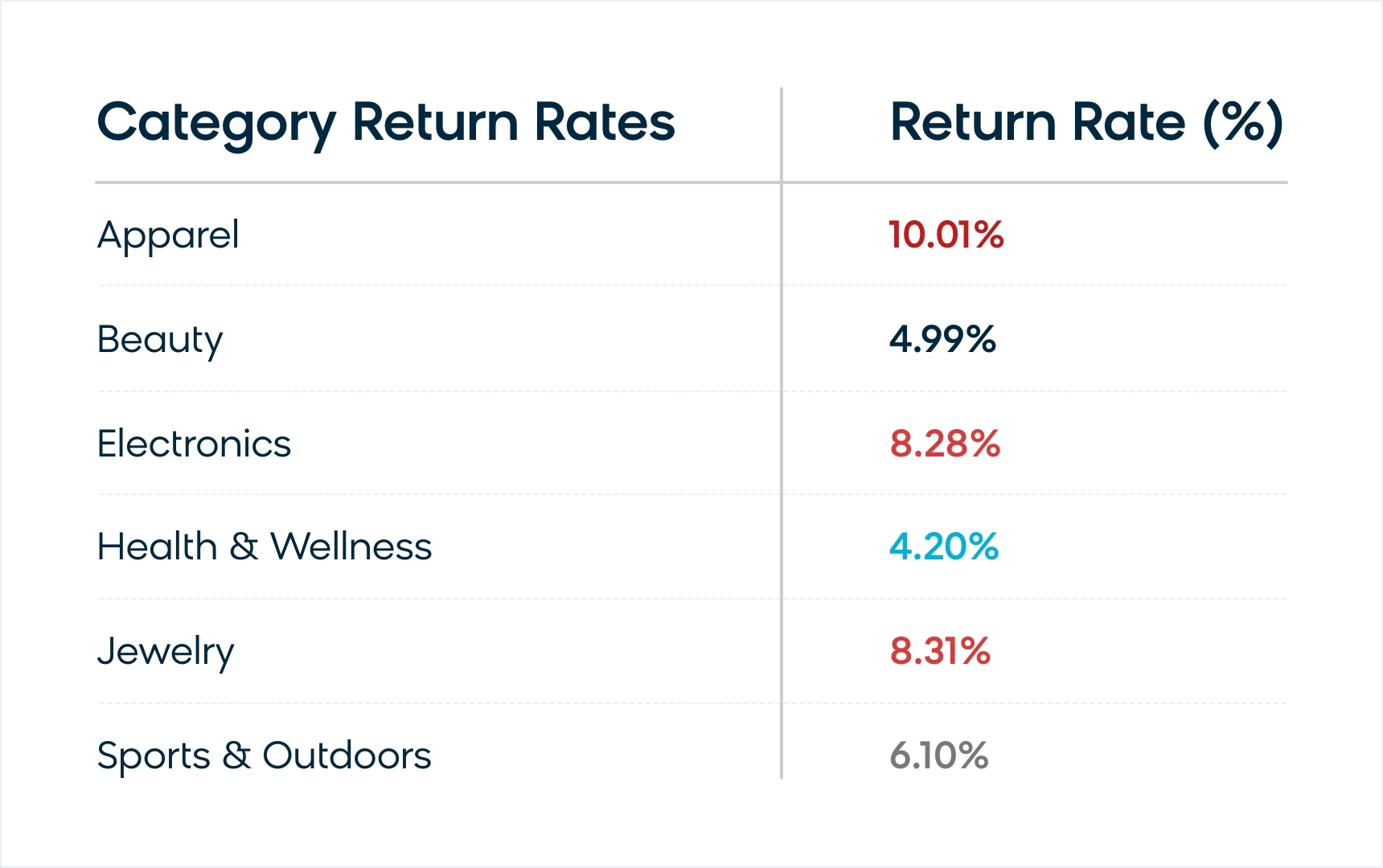
With apparel slightly over 10% and jewelry and electronics approaching 10%, it’s easy to see why so many online retailers are frustrated by ecommerce returns.
Ecommerce returns can be costly for retailers due to factors such as shipping expenses, restocking fees, and potential loss in value for returned items. Studies suggest that the cost of processing a return can range from 20% to 65% of the item's original value.
According to the Wall Street Journal, ecommerce return rates were 14% higher in 2022 compared to 2019, and on average, the cost to process $100 worth of returned merchandise is about $26.50. The WSJ estimated that if a retailer cut returns in half, it would result in 25% increased profit.
These statistics highlight the significance of managing ecommerce returns effectively and provide insights into the impact of returns on retailers and customer behavior.
Strategies for Lowering Your Ecommerce Return Rate
Fortunately, there are ways to avoid becoming just another company getting crushed by ecommerce returns. Lowering your ecommerce return rate requires a proactive approach to address the underlying factors that contribute to returns.
By implementing these strategies via your content management system, you can proactively address common causes of returns and minimize the overall return rate for your ecommerce business. Remember, an informed and satisfied customer is less likely to return a product, so prioritize transparency, accurate information, and exceptional customer service throughout the customer journey.
Write Accurate Product Descriptions
Providing detailed and accurate product descriptions, including specifications, dimensions, materials, and high-quality images, will go a long way in helping your customers perfectly understand what they’re purchasing. Clear and comprehensive information helps set accurate customer expectations, reducing the likelihood of returns due to product dissatisfaction.
Share Product Videos and Demos
Create product videos or demos that showcase the features, functionality, and usage of your products. Visual demonstrations can help customers gain a better understanding of the product and reduce misunderstandings, leading to fewer returns.
Provide Size and Fit Guidance
For apparel and other size-dependent product offerings, provide detailed size charts, measurements, and fit guidance to assist customers in selecting the appropriate size. This reduces the chances of returns due to sizing issues.
Add Enhanced Product Images
Utilize high-resolution images and multiple angles to provide customers with a clear visual representation of the product. Visuals can help customers better understand the appearance, features, and details of the item to prevent surprises upon delivery.
Use Quality Control Methods
Implement stringent quality control measures to ensure that products are thoroughly inspected and meet high standards before they are shipped. This includes checking for defects, damages, or incorrect items. By minimizing the shipment of faulty products, you can reduce returns resulting from product quality issues.
Sustainable Commerce and Ecommerce Returns
Consider also that ecommerce returns can have an impact on the environment and your company’s sustainable commerce efforts.
While ecommerce provides consumers with convenience and accessibility, it also generates a significant amount of waste due to the high return rates and packaging materials used. This is an issue that shoppers are becoming more concerned about — consumers are actively trying to be more environmentally sustainable, and they expect companies to be, too.

To address this, many ecommerce retailers are adopting sustainable practices and finding ways to reduce their environmental impact. Here are some ways that sustainable commerce and ecommerce returns are intersecting:
Product Lifecycle Management: Implementing the best possible product lifecycle management practices will help to extend the life of the products that ecommerce retailers are selling and in turn reduce waste. This includes refurbishing, repairing, or recycling items to keep them out of landfills.
Sustainable packaging: Many online stores are now making product packaging with sustainable materials and reducing the use of plastic packaging needed to ship items to customers. They are also eliminating excessive packaging.
Donation: Some ecommerce retailers are partnering with charities or similar-type organizations to offer their customers the option to donate returned items to those in need. This helps to reduce the amount of waste generated by ecommerce returns and it provides support to those in need in the community.
Resale: Similarly, retailers can also consider reselling returned items on the secondary market. This would reduce the waste created by ecommerce returns and generate additional revenue simultaneously.
By adopting sustainable practices in areas such as packaging, donation, and resale, ecommerce retailers can reduce their environmental impact and contribute to a more sustainable future. Additionally, by improving product quality and implementing product lifecycle management practices, they can reduce their ecommerce return rate, leading to increased customer satisfaction and profitability.
Using Artificial Intelligence To Improve Your Ecommerce Return Rate
In today’s competitive marketplace, artificial intelligence (AI) has had a massive impact on ecommerce in general. And while it hasn’t been utilized much in ecommerce returns specifically, there are game-changing ways to leverage AI and reduce returns.
AI offers the ability to help companies deeply understand their customers and orchestrate a richer and more personalized customer experience. This has massive implications for return rates — the more tailored the customer experience is, the better your shoppers will understand what they’re purchasing, which can impact ecommerce returns by reducing the sizing, fit, fabric, or feel issues that often lead to product returns.
Plus, an AI-powered ecommerce experience helps with important factors like limiting the strain on reverse logistics, handling inventory management, and more.
But in terms of directly targeting and lowering return rates for your ecommerce business, AI's targeted segmentation abilities provides a whole new toolkit for managing ecommerce returns. It can help you identify and address the customers that have the highest returns rates, allowing you to actively reduce returns and build customer loyalty in the process.
How AI Can Identify “Heavy Returners” and Reduce Return Rates
One of the most important things that artificial intelligence can do for your business is to help you identify who your “heavy returners” are and where specifically they are hiding in your customer base.
Heavy returners in ecommerce are customers who frequently return items they have purchased online. Typically, these customers have a higher-than-average return rate and may return items for a variety of reasons, such as purchasing the wrong size, color, or fit, dissatisfaction with product quality, or simply changing their mind about the purchase.
Heavy returners can be a significant challenge for ecommerce retailers. While only a small number of customers tend to account for a large number of a retailer’s returns, they can impact profitability, overall customer satisfaction, and operational efficiency.
Identifying heavy returners is important for ecommerce retailers as it can help them develop targeted strategies to reduce returns and prevent loss of revenue. But singling out these serial returners is not an easy task. You need to track customer order history, analyze return data, and identify patterns in customer behavior that lead to returns, and the only way to do this efficiently and effectively is with an AI-powered solution.
And once these customers are identified, ecommerce retailers can take steps to address the root causes of returns for heavy returners, such as improving product descriptions, offering alternative options, providing better sizing information, and enhancing customer service.
Plus, these heavy returners can be segmented by their return rate for a more proactive approach to reducing returns.
Once you have segmented your heavy returners, you can orchestrate their customer experience with your brand to limit their likeliness to increase return rates. You have the option to refrain from showing them discounts for products (as they are apt to return them) and products with a low margin. Or consider only showing them payment methods that are better for your company’s bottom line, even if they may be less convenient for them.
While you certainly don’t want to take that approach with all segments of your customer base, it is a profitable strategy to mitigate the risk that these customers pose to your business. With a thoughtful approach to managing the interactions your heavy returners have with your brand, you can better manage the amount of returns this customer segment requests from your business.
How To Mitigate Ecommerce Returns With Bloomreach Engagement
Having the right marketing technology in your tech stack will allow you to easily segment your heavy returners and to go even further in your quest to mitigate ecommerce returns.
Utilizing a customer data platform and marketing automation tool like Bloomreach Engagement allows you to deploy very specific use cases that can help soften the financial damage done by ecommerce returns. Or it allows you to use an out-of-the box dashboard to manage returns more effectively.
The aforementioned use case and these four additional ones — specifically designed to lower your ecommerce return rate — are a great place to start.
Weblayers To Prevent Purchase of the Same Item in Different Sizes
Weblayers are personalized banners that are shown to customers on specific pages of your website. They’re a great way to drive engagement and conversions, and are executed via HTML, CSS, and JavaScript.
If a customer has the exact same item in their online shopping cart multiple times in different sizes, deploy a weblayer that links to a sizing guide or customer service representative. These two options would help the customer find their true size for the item in their cart.
Using this tactic will help reduce the number of returns of duplicate items bought in different sizes. Very few shoppers are setting up their carts with the intent of keeping both of these differently sized items, and this weblayer helps avoid identical purchases, reducing your costs and improving profit margins.
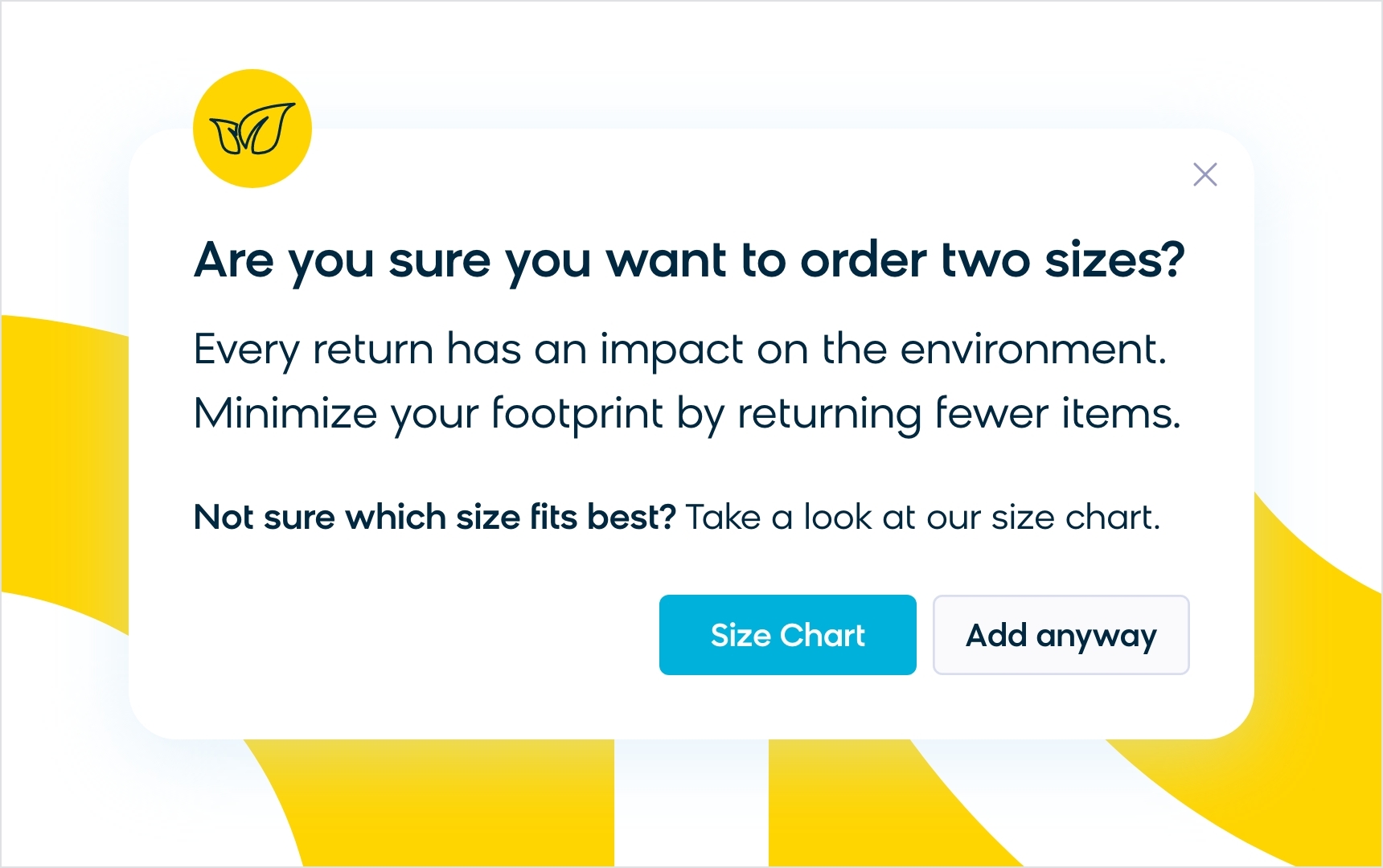
Experiments To Prevent Purchase of the Same Item in Different Sizes
Similar to the use case above, you can use experiments to trigger an alert to customers that have the exact same item in multiple different sizes in their cart prior to them making the purchase.
Experiments are a web optimization and web personalization tool that allow you to make any changes to your website using a simple visual editor — without needing to deploy code. Once again, your messaging could point customers to a sizing chart or customer representative to help determine which size would be best, potentially leading to cost savings for your company by mitigating a future product return.
Daily Exclusion of Low-Profit Customers From Retargeting
It’s simple to use Bloomreach Engagement to find low- and negative-profit customers via our single customer view and our advanced customer segmentation. And you can use this to your advantage and lower your ecommerce return rate by removing these customers from your Facebook and Google retargeting audiences.
This will save you ad budget by not targeting customers who aren’t profitable for your business, and can lead to lowering your ecommerce return rate as well.
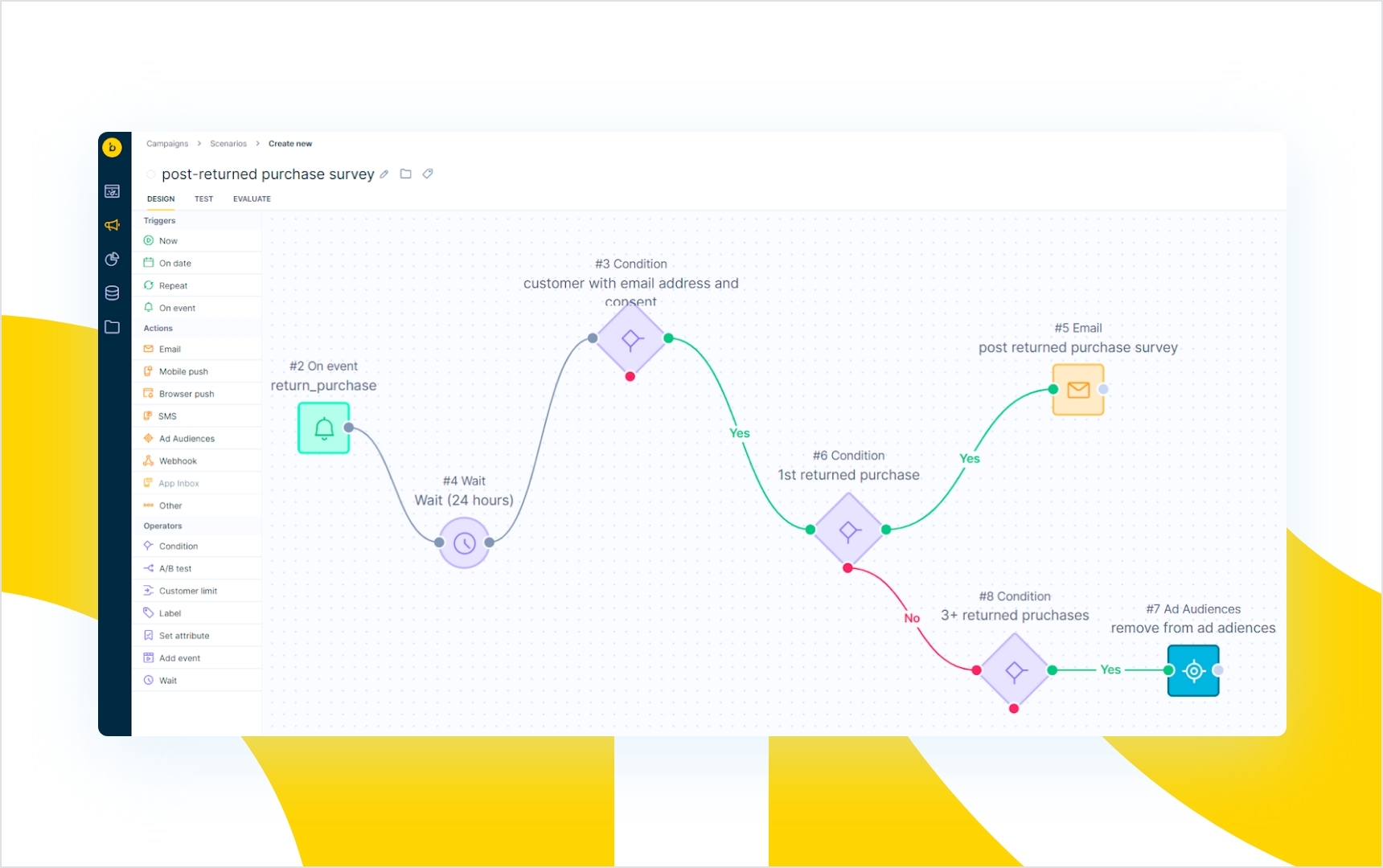
Boosting High-Profit Products in Product Recommendation Models
Using personalized product recommendations to help customers find what they want with your brand is a great strategy for driving revenue and fostering happy customers.
While there’s certainly a chance that these product recommendations could recommend products that customers ultimately return, you can help mitigate that cost by optimizing your product recommendations for higher-profit products. This builds in potential ecommerce return costs so your company isn’t negatively impacted if customers do indeed decide to return.
Read this next: Yves Rocher Wins With Personalized Product Recommendations
Bloomreach Can Help Lower Your Ecommerce Return Rate
As online purchases continue to dominate the retail landscape and contribute to total retail sales, it becomes increasingly crucial for ecommerce businesses to address the challenge of customer returns. To do this, an AI-powered marketing technology is essential — one like Bloomreach Engagement that offers the necessary tools to proactively address returns.
Bloomreach Engagement is a single, flexible platform that allows you to put your collected customer data to work in lowering your ecommerce return rate. With the power of Loomi, our AI for ecommerce, you can effortlessly analyze and deeply understand the factors contributing to your return rates and craft the right customer experiences to reach the right audiences, foster customer loyalty, and achieve profitable and sustainable growth.
Found this useful? Subscribe to our newsletter or share it.









